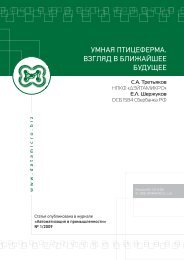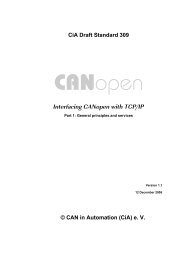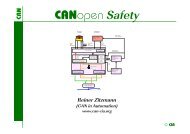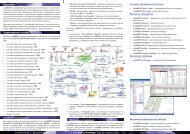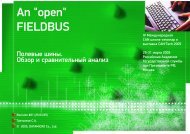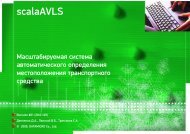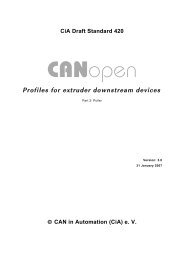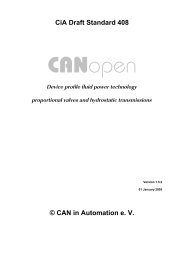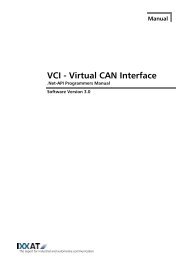CiA Draft Standard 304 © CAN in Automation (CiA) e. V. - datamicro.ru
CiA Draft Standard 304 © CAN in Automation (CiA) e. V. - datamicro.ru
CiA Draft Standard 304 © CAN in Automation (CiA) e. V. - datamicro.ru
- No tags were found...
You also want an ePaper? Increase the reach of your titles
YUMPU automatically turns print PDFs into web optimized ePapers that Google loves.
DS <strong>304</strong> V1.0.1 <strong>CAN</strong>open framework for safety-relevant communication <strong>CiA</strong>HistoryDate Version Changes2001-01-01 1.0 Release as <strong>Draft</strong> <strong>Standard</strong> Proposal2005-01-01 1.0.1 Publication as <strong>Draft</strong> <strong>Standard</strong>• Editorial corrections• Inclusion of errata• Harmonization of term<strong>in</strong>ologyGeneral <strong>in</strong>formation on licens<strong>in</strong>g and patents<strong>CAN</strong> <strong>in</strong> AUTOMATION (<strong>CiA</strong>) calls attention to the possibility that some of the elements of this <strong>CiA</strong>specification may be subject of patent rights. <strong>CiA</strong> shall not be responsible for identify<strong>in</strong>g any or all suchpatent rights.<strong>©</strong> <strong>CiA</strong> 2005-01-01All rights reserved. Unless otherwise specified, no part of this publication may be reproduced or utilized <strong>in</strong> any form or by anymeans, electronic or mechanical, <strong>in</strong>clud<strong>in</strong>g photocopy<strong>in</strong>g and microfilm, without permission <strong>in</strong> writ<strong>in</strong>g from <strong>CiA</strong> at the addressbelow.<strong>CAN</strong> <strong>in</strong> <strong>Automation</strong> e. V.Am Weichselgarten 26DE - 91058 Erlangen, GermanyTel.: +49-9131-69086-0Fax: +49-9131-69086-79Url: www.can-cia.orgEmail: headquarters@can-cia.orgii<strong>©</strong> <strong>CiA</strong> 2005 – All rights reserved
DS <strong>304</strong> V1.0.1 <strong>CAN</strong>open framework for safety-relevant communication <strong>CiA</strong>1 ScopeThe services and protocols def<strong>in</strong>ed <strong>in</strong> this document are <strong>in</strong>tended to be an add-on to the <strong>CAN</strong>openapplication layer and communication profile.Safety-relevant communication is an additional property of such devices. The manufacturer and thesystem <strong>in</strong>tegrator shall take care, that the safety requirements are allocated to safe communicationobjects, that the hardware and software of the device support the safety function and that the device isoperated with<strong>in</strong> its safe limits.This specification describes only the data transport mechanism on a <strong>CAN</strong>open network, that allowsthe exchange of safety-relevant data.Due to <strong>CAN</strong>open compatibility communication is limited to 64 safe communication objects, so up to 64suppliers of safety-relevant objects can operate <strong>in</strong> a <strong>CAN</strong>open network. The number of consumers ofthe safety-relevant objects is not def<strong>in</strong>ed (at least one receiver is necessary).<strong>©</strong> <strong>CiA</strong> 2005 – All rights reserved 5
DS <strong>304</strong> V1.0.1 <strong>CAN</strong>open framework for safety-relevant communication <strong>CiA</strong>2 References2.1 Normative references/<strong>CiA</strong>301//EN954-1//IEC61508/<strong>CiA</strong> DS 301, <strong>CAN</strong>open application layer and communication profileEN 954-1, Safety related parts of control systems - Part 1: General pr<strong>in</strong>ciplesof designIEC 61508, Functional safety of electrical/electronic/programmable electronicsafety-related systems/DIN801/DIN V VDE 0801, G<strong>ru</strong>ndsätze für Rechner <strong>in</strong> Systemen mit Sicherheitsaufgaben2.2 Informative references/CHAR//FAET/Charz<strong>in</strong>siki:1991, Bewertung der Fehlersiche<strong>ru</strong>ngsverfahren im <strong>CAN</strong>-Protokoll, Universität StuttgartG<strong>ru</strong>ndsatz für die Prüfung und Zertifizie<strong>ru</strong>ng von “Bussystemen für die Übertragungsicherheitsrelevanter Nachrichten”, Fachausschuss Elektrotechnik,Köln, Ausgabe 05.02, GS-ET-266 <strong>©</strong> <strong>CiA</strong> 2005 – All rights reserved
DS <strong>304</strong> V1.0.1 <strong>CAN</strong>open framework for safety-relevant communication <strong>CiA</strong>3 Abbreviations and def<strong>in</strong>itions3.1 AbbreviationsAK Anforde<strong>ru</strong>ngsklassen - requirement classesBIA Be<strong>ru</strong>fsgenossenschaftliches Institut für Arbeitssicherheit - Institute for occupationalsafety of accident <strong>in</strong>surance <strong>in</strong>stitutions<strong>CAN</strong> Controller area network<strong>CAN</strong>-ID <strong>CAN</strong> identifierCOB Communication objectCOB-ID COB identifierGFC Global failsafe commandNMT Network managementPLC Programmable logic controllerRTR Remote transmission requestSCT Safeguard cycle timeSIL Safety <strong>in</strong>tegrity levelSRDO Safety-relevant data objectSRVT Safety-relevant object validation timeTÜV Technischer Überwachungsvere<strong>in</strong> - German association for technical <strong>in</strong>spection3.2 Def<strong>in</strong>itionsThe def<strong>in</strong>itions given <strong>in</strong> /<strong>CiA</strong>301/ apply for this framework, too.Safety controllerdevice that consumes safety-relevant data<strong>©</strong> <strong>CiA</strong> 2005 – All rights reserved 7
DS <strong>304</strong> V1.0.1 <strong>CAN</strong>open framework for safety-relevant communication <strong>CiA</strong>4 Operat<strong>in</strong>g pr<strong>in</strong>ciple4.1 Theory of safe operationIt is absolutely essential for a safe system, that there is a safe state. A reaction to an emergencycommand, an alarm or an error, the safe-state is entered.It is also important, that the functionality of the safeguard measures is regularly checked. A s<strong>in</strong>gledefect <strong>in</strong> a safety-relevant communication shall not override the safety circuitry! If such an error occurs,it shall be detected with<strong>in</strong> a short period of time <strong>in</strong> which a second error is unlikely to happen.All the systems, especially the safety-relevant circuitry shall have a high reliability <strong>in</strong> order to extendthe time-span between the safety-tests and m<strong>in</strong>imize the down-time of the whole system (e.g. if one ofredundant components fails, the system shall be shut-off). So the need for safety decreases the availabilityof a system.The idea of safety <strong>in</strong> <strong>CAN</strong> communication is not to ensure, that there are absolutely no errors andfaults. This would be rather hard to proof - anyway. The goal is to detect all possible errors and react<strong>in</strong> a predictable (safe) way.In a safe <strong>CAN</strong> system there are sources of safe <strong>in</strong>formation (e.g. safety switches, light barriers, emergencystop buttons) and consumers of such <strong>in</strong>formation (e.g. relay, valve or drive controll<strong>in</strong>g a possiblydangerous movement, safety PLC). As the "consumers" control the possible dangerous situation itis responsible for enter<strong>in</strong>g the safe-state after any safety-relevant <strong>in</strong>terference. It also shall check thedata <strong>in</strong>tegrity of the safety-relevant communication.As the sources (safety <strong>in</strong>puts) are the orig<strong>in</strong> of safe communication objects (SRDOs), their number islimited to 64. The number of safety controllers is not limited <strong>in</strong> theory, as <strong>CAN</strong> allows many consumersto listen to the same SRDO(s), i.e. many actuator devices use the same <strong>in</strong>formation.As the safety controllers are responsible for the data <strong>in</strong>tegrity and actuality, every safety-relevant outputdevice shall to survey all correspond<strong>in</strong>g sources of safety-relevant data.4.2 <strong>Standard</strong> <strong>CAN</strong>open functionsIt is <strong>in</strong>tended, that the additional safe communication is not affect<strong>in</strong>g the normal operation and serviceson a <strong>CAN</strong>open network. Safe communication is not related to a special class of devices, so nospecial device profile is required.PLC<strong>CAN</strong>Safety PowerSwitchS1 N1 S2 N2 N3 D1S3EmergencyPush ButtonSLMSx Safety Node (S3: Saftey controller)Nx Normal NodeDx Drive ControllMDriveControllFigure 1: Example of a <strong>CAN</strong>open network with safety-relevant devices8 <strong>©</strong> <strong>CiA</strong> 2005 – All rights reserved
DS <strong>304</strong> V1.0.1 <strong>CAN</strong>open framework for safety-relevant communication <strong>CiA</strong>A second test determ<strong>in</strong>es, if there is sufficient network capacity for a safety system. Both <strong>CAN</strong> framesthat make an SRDO shall be received correctly with<strong>in</strong> the given SRVT. Normally both <strong>CAN</strong> frames aretransmitted with m<strong>in</strong>imum delay. If the 2nd <strong>CAN</strong> frame is not be<strong>in</strong>g received with<strong>in</strong> SRVT, the networkmay have reduced transmission capabilities. The reaction time on a safety-relevant event is enlarged.If the SRVT expires, the safety controller shall transit to the safe state.SRDOSRDO SRDO SRDO?SRVTSRVTSRVTSRVTSRVTexpiredtFigure 3: Example for SRVT tim<strong>in</strong>g10 <strong>©</strong> <strong>CiA</strong> 2005 – All rights reserved
DS <strong>304</strong> V1.0.1 <strong>CAN</strong>open framework for safety-relevant communication <strong>CiA</strong>5 SRDO def<strong>in</strong>ition5.1 SRDO services5.1.1 GeneralSRDO transmission follows the producer/consumer relationship <strong>in</strong> /<strong>CiA</strong>301/ and consists of two <strong>CAN</strong>data frames.Attributes:• SRDO number: SRDO number [1..64] for every user type on the local device• user type: one of the values {consumer, producer}• data type: accord<strong>in</strong>g to the SRDO mapp<strong>in</strong>g• refresh-time: n*1 ms, n > 0• validation-time: n*1 ms, n > 05.1.2 Write SRDOFor the write SRDO service the push model shall be used. There shall be one or more consumers ofan SRDO. An SRDO shall have exactly one producer.Through this service the producer of an SRDO shall send the data of the mapped application object tothe consumer(s).Table 1: Write SRDOParameterArgumentSRDO numberDataRequest / IndicationMandatoryMandatoryMandatory5.1.3 Read SRDOThe read SRDO service shall be not allowed.5.2 SRDO protocol5.2.1 Write SRDO protocolThe service for an SRDO write request shall be unconfirmed. The SRDO producer shall send theprocess data with<strong>in</strong> an SRDO to the network. There may be 1 to an SRDO consumers. At the SRDOconsumer(s) the reception of a valid SRDO shall be <strong>in</strong>dicated.<strong>©</strong> <strong>CiA</strong> 2005 – All rights reserved 11
DS <strong>304</strong> V1.0.1 <strong>CAN</strong>open framework for safety-relevant communication <strong>CiA</strong>SRDOproducerRequest0Write SRDOL (0 ≤ L ≤ 8)Process dataSRDOconsumer(s)Bit-wise <strong>in</strong>verted process dataSRVTIndication(s)re-fresh-Request0 L (0 ≤ L ≤ 8)Process dataSRVTBit-wise <strong>in</strong>verted process dataSCTIndication(s)Indication(s)SRVT eventIndication(s)SCT eventFigure 4: Write SRDO protocolProcess-data: up to L bytes of application data accord<strong>in</strong>g to the SRDO mapp<strong>in</strong>g.If L exceeds the number 'n' def<strong>in</strong>ed by the actual SRDO mapp<strong>in</strong>g length, only the first 'n' bytes shall beused by the consumer. If L is less than 'n' the data of the received SRDO shall be not processed andan Emergency message with error code 8210 h shall be produced if Emergency is supported.An SRDO shall not be requested by RTR.12 <strong>©</strong> <strong>CiA</strong> 2005 – All rights reserved
DS <strong>304</strong> V1.0.1 <strong>CAN</strong>open framework for safety-relevant communication <strong>CiA</strong>6 Global fail-safe command6.1 GFC usageIn order to speed up the system reaction time, the GFC may be used.If one transmission at least have been received, the GFC shall be already valid. It allows only onereaction <strong>in</strong> a <strong>CAN</strong> network. For that reason, the usage of the GFC is optional. It is event-driven onlyand not safe (no periodic time expectation).Example: After a safety-relevant change at a device <strong>in</strong>put, the GFC may be transmitted first (optional),then the correspond<strong>in</strong>g SRDO shall follow to ma<strong>in</strong>ta<strong>in</strong> safety.6.2 GFC service6.2.1 Write GFCThe GFC transmission shall follow the producer/consumer push model as described <strong>in</strong> /<strong>CiA</strong>301/. Theservice shall be unconfirmed; the correspond<strong>in</strong>g SRDO shall follow.Attributes:• user type: one of the values {consumer, producer}• data type: nil6.3 GFC protocol6.3.1 Write GFCGFCproducerRequestWrite GFC<strong>CAN</strong>-ID = 1L = 0GFCconsumer(s)Indication(s)0 L (0 ≤ L ≤ 8)RequestProcess data0 L (0 ≤ L ≤ 8)Bit-wise <strong>in</strong>verted process dataIndication(s)SRVTIndication(s)SRVT EventFigure 5: Write GFC protocol<strong>©</strong> <strong>CiA</strong> 2005 – All rights reserved 13
DS <strong>304</strong> V1.0.1 <strong>CAN</strong>open framework for safety-relevant communication <strong>CiA</strong>7 Network <strong>in</strong>itialisation and system boot-up7.1 Initialisation procedure for safety networksThe network <strong>in</strong>itialisation process is controlled by the NMT master application or configuration application.Configuration of all device parameters,<strong>in</strong>clud<strong>in</strong>g communication parameters(via default SDO)A(Optional)Start transmission of SYNC, wait forsynchronisation of all devicesB(Optional)Start of node guard<strong>in</strong>g or heartbeatCVerify safetyconfiguration parametersDSett<strong>in</strong>g of all devices tothe NMT state operationalEFigure 6: Flow chart of the network <strong>in</strong>itialisation process for safety networksIn step A the devices shall be <strong>in</strong> the NMT state pre-operational, which is entered automatically afterpower-on. In this state, the devices are accessible via their default SDO us<strong>in</strong>g <strong>CAN</strong>-IDs that are beenassigned accord<strong>in</strong>g to the pre-def<strong>in</strong>ed connection set. In this step, the configuration of device parameterstake place on all devices, which support parameter configuration. Some configuration dataare safety-relevant. So additional measures shall be taken, to ensure the safety function <strong>in</strong> the network.This is done from a configuration application or tool, which resides on the device that is the client forthe default SDOs. For devices that support these features the selection and/or configuration of PDOs,the mapp<strong>in</strong>g of application objects (PDO mapp<strong>in</strong>g), the selection and/or configuration of SRDOs, themapp<strong>in</strong>g of application objects (SRDO mapp<strong>in</strong>g), the configuration of additional SDOs and optionallythe sett<strong>in</strong>g of COB-IDs may be performed via the default SDO objects.In many cases, a configuration is not necessary as default values are def<strong>in</strong>ed for all application andcommunication parameters.If the application requires the synchronisation of all or some nodes <strong>in</strong> the network, the appropriatemechanisms may be <strong>in</strong>itiated <strong>in</strong> the optional step B. It may be used to ensure that all devices exceptsafety nodes are synchronised by the SYNC object before enter<strong>in</strong>g the NMT state operational <strong>in</strong> stepE. The first transmission of SYNC object starts with<strong>in</strong> 1 sync cycle after enter<strong>in</strong>g the NMT state preoperational.In step C node guard<strong>in</strong>g may be activated (if supported) us<strong>in</strong>g the guard<strong>in</strong>g parameters configured <strong>in</strong>step A.14 <strong>©</strong> <strong>CiA</strong> 2005 – All rights reserved
DS <strong>304</strong> V1.0.1 <strong>CAN</strong>open framework for safety-relevant communication <strong>CiA</strong>In step D there shall be a method performed for the check of the authenticity of the configuration data.It covers the follow<strong>in</strong>g safety relevant configuration objects:• SRDO numbers(s) used• Time expectation (refresh time, SCT, and the SRVT)• Information direction• Mapp<strong>in</strong>g parameterThe checksum of the respective configuration entries shall be def<strong>in</strong>ed, that the safe application maycheck if a safety configuration tool has been used and that the content of the configuration entries hasnot been changed <strong>in</strong> state operational In case of mismatch, the safety node shall not transmit SRDOs;the safety controller shall enter (or shall stay <strong>in</strong>) the safe state.7.2 NMT states for safety devices7.2.1 GeneralThe "safe state" of a device is not a <strong>CAN</strong>open communication state and falls not <strong>in</strong> the scope of thisframework.7.2.2 Pre-operationalIn the NMT state pre-operational, communication via SDOs is possible, however SRDO and PDOcommunication shall be not allowed. Configuration of SRDOs, PDOs, device parameters and also theallocation of application objects (PDO mapp<strong>in</strong>g) may be performed by a configuration application. Thedevice may be switched <strong>in</strong>to the NMT state operational directly by send<strong>in</strong>g a Start_Remote_Noderequest. In the NMT state pre-operational the application is <strong>in</strong> the safe-state.7.2.3 OperationalIn the NMT state pre-operational, SRDO and PDO communication are active, however SDO writeaccess shall be is not possible. For the safe application this is the only work<strong>in</strong>g state (e.g. motor on).Safety communication is only supported <strong>in</strong> this state.7.2.4 StoppedBy switch<strong>in</strong>g a safety device <strong>in</strong> the NMT state stopped limits the communication to NMT messages.The application shall be <strong>in</strong> the safe state.7.2.5 Relation of NMT states and COBsTable 2 shows the relation between NMT states and COBs. Services on the listed COBs shall only beexecuted if the device is <strong>in</strong> one of the appropriate NMT states.Table 2: States and communication objectsINITIALISING PRE-OPERATIONAL OPERATIONAL STOPPEDPDO AllowedSDO Allowed Allowed 1SRDO AllowedSynchronization object Allowed AllowedTime stamp object Allowed AllowedEmergency object Allowed AllowedBoot-up object AllowedNMT object Allowed Allowed Allowed1 Writ<strong>in</strong>g to a safety object <strong>in</strong> the NMT state operational shall lead to an abort message (abortcode: 0800 0022 h ). Read<strong>in</strong>g of a safety entry <strong>in</strong> the NMT state operational is allowed.<strong>©</strong> <strong>CiA</strong> 2005 – All rights reserved 15
DS <strong>304</strong> V1.0.1 <strong>CAN</strong>open framework for safety-relevant communication <strong>CiA</strong>8 Pre-def<strong>in</strong>ed connection setIn order to reduce configuration effort for simple networks, a mandatory default identifier allocationscheme is def<strong>in</strong>ed <strong>in</strong> /<strong>CiA</strong>301/.This pre-def<strong>in</strong>ed connection set is extended to support one SRDOs for every safety device with anode-ID between 1 and 64. Devices with a node-ID, which is higher than 64, shall not have predef<strong>in</strong>ed<strong>CAN</strong>-ID assigned for SRDOs.Table 3: Broadcast objects of the pre-def<strong>in</strong>ed connection setObject Function code Result<strong>in</strong>g <strong>CAN</strong>-IDsGFC 0000 b 1 (001 h )ObjectTable 4: Peer-to-peer objects of the pre-def<strong>in</strong>ed connection setFunction Result<strong>in</strong>g <strong>CAN</strong>-IDscode Normal data Complement dataCommunicationparameters at <strong>in</strong>dexChanneldirectionSRDO(node-ID 1 to 32)SRDO(node-ID 33 to 64)(1)0010 b257 d to 319 d(1)(101 h to 13F h )0010 b321 d to 383 d(1)(141 h to 17F h )Every second <strong>CAN</strong>-ID is used.258 d to 320 d(1)(102 h to 140 h )322 d to 384 d(1)(142 h to 180 h )1301 h to 1340 h tx1301 h to 1340 h rx16 <strong>©</strong> <strong>CiA</strong> 2005 – All rights reserved
DS <strong>304</strong> V1.0.1 <strong>CAN</strong>open framework for safety-relevant communication <strong>CiA</strong>9 Object dictionary9.1 Complex data type9.1.1 SRDO communication parameter recordIndex Sub-Index Description Data type0026 h 00 h Highest sub-<strong>in</strong>dex supported UNSIGNED801 h Information direction UNSIGNED802 h Refresh-time/SCT UNSIGNED1603 h SRVT UNSIGNED804 h Transmission type UNSIGNED805 h COB-ID 1 UNSIGNED3206 h COB-ID 2 UNSIGNED329.2 Object dictionary specifications9.2.1 Object 1300 h : Global fail-safe command parameterVALUE DEFINITION00 h : GFC is not valid01 h : GFC is valid02 h to FF h : reservedOBJECT DESCRIPTIONINDEXNameObject codeData typeCategory1300 hGlobal failsafe command parameterVARUNSIGNED8OptionalENTRY DESCRIPTIONAccessPDO mapp<strong>in</strong>gValue rangeDefault valuerwNoSee value def<strong>in</strong>ition00 h9.2.2 Object 1301 h to 1340 h : SRDO communication parameterThese objects shall conta<strong>in</strong> the communication parameters for the SRDOs the device is able to receiveor to transmit. The type of the SRDO communication parameter (26 h ) is described <strong>in</strong> 9.1.1.The sub-<strong>in</strong>dex 00 h shall conta<strong>in</strong> the number of highest entry with<strong>in</strong> the communication record.At sub-<strong>in</strong>dex 01 h shall reside the <strong>in</strong>formation direction of the SRDO. The SRDO <strong>in</strong>formation directionallows to select if it is used as a receive SRDO or as a transmit SRDO <strong>in</strong> the operational state. Theremay be SRDOs fully configured (e.g. by default) but not used, and therefore set to "not valid" (de-<strong>©</strong> <strong>CiA</strong> 2005 – All rights reserved 17
DS <strong>304</strong> V1.0.1 <strong>CAN</strong>open framework for safety-relevant communication <strong>CiA</strong>Sub-<strong>in</strong>dexDescriptionEntry categoryAccessPDO mapp<strong>in</strong>gValue rangeDefault value03 hnot used (if <strong>in</strong>formation direction is tx)SVT (if <strong>in</strong>formation direction is rx)Conditional (if <strong>in</strong>formation direction is rx)rw (only <strong>in</strong> NMT state pre-operational)NoUNSIGNED1620 dSub-<strong>in</strong>dexDescriptionEntry categoryAccessPDO mapp<strong>in</strong>gValue rangeDefault value04 hTransmission typeMandatoryroNo254 d254 dSub-<strong>in</strong>dex05 hDescription COB-ID 1Entry category MandatoryAccessrw (only <strong>in</strong> NMT state pre-operational)PDO mapp<strong>in</strong>g NoValue rangeOdd values only: 257 d to 383 dDefault value 1301 h : 0000 00FF h + (2 x node-ID)1302 h to 1340 h : manufacturer-specificSub-<strong>in</strong>dex06 hDescription COB-ID 2Entry category MandatoryAccessrw (only <strong>in</strong> NMT state pre-operational)PDO mapp<strong>in</strong>g NoValue rangeEven values only: 258 d to 384 dDefault value 1301 h : 0000 0100 h + (2 x node-ID)1302 h to 1340 h : manufacturer-specific20 <strong>©</strong> <strong>CiA</strong> 2005 – All rights reserved
DS <strong>304</strong> V1.0.1 <strong>CAN</strong>open framework for safety-relevant communication <strong>CiA</strong>9.2.3 Object 1381 h to 13C0 h : SRDO mapp<strong>in</strong>g parameterThese objects shall conta<strong>in</strong> the mapp<strong>in</strong>g parameters for the SRDOs the device is able to receive ortransmit. The type of the SRDO mapp<strong>in</strong>g parameter is an array of type UNSIGNED32. The sub-<strong>in</strong>dex00 h conta<strong>in</strong>s the number of valid entries with<strong>in</strong> the mapp<strong>in</strong>g array. This half of the number of entries isalso the number of the application variables, which shall be received/transmitted with the correspond<strong>in</strong>gSRDO. The sub-<strong>in</strong>dices from 01 h to number of entries conta<strong>in</strong> the <strong>in</strong>formation about the mappedapplication variables. The st<strong>ru</strong>cture and the procedure for the mapp<strong>in</strong>g is described <strong>in</strong> /<strong>CiA</strong>301/. Forchang<strong>in</strong>g the SRDO mapp<strong>in</strong>g first the SRDO shall be deleted.VALUE DEFINITIONSub-<strong>in</strong>dex 00 h :00 h : mapp<strong>in</strong>g not valid02 h , 04 h to 80 h (only even values): mapp<strong>in</strong>g valid01 h , 03 h to 7F h (only odd values): reservedSub-<strong>in</strong>dex 01 h to 80 h :See PDO mapp<strong>in</strong>g parameters <strong>in</strong> /<strong>CiA</strong>301/.OBJECT DESCRIPTIONINDEXNameObject codeData typeCategory1381 h to 13C0 hSRDO mapp<strong>in</strong>g parameterARRAYUNSIGNED32Mandatory for each supported SRDOENTRY DESCRIPTIONSub-<strong>in</strong>dexDescriptionEntry categoryAccessPDO mapp<strong>in</strong>gValue rangeDefault value00 hHighest sub-<strong>in</strong>dex supportedMandatoryro or rw (only <strong>in</strong> NMT state preoperational,and if variable mapp<strong>in</strong>g issupported)NoSee value def<strong>in</strong>ition(Device profile dependent)<strong>©</strong> <strong>CiA</strong> 2005 – All rights reserved 21
DS <strong>304</strong> V1.0.1 <strong>CAN</strong>open framework for safety-relevant communication <strong>CiA</strong>Sub-<strong>in</strong>dexDescriptionEntry categoryAccessPDO mapp<strong>in</strong>gValue rangeDefault value01 h , 03 h , 05 h to 7F h (only odd <strong>in</strong>dices)SRDO mapp<strong>in</strong>g for the n-th applicationobject to be mapped (data not <strong>in</strong>verted)Conditional; depends on number of objectsto be mappedrwNoUNSIGNED32(Device profile dependent)Sub-<strong>in</strong>dexDescriptionEntry categoryAccessPDO mapp<strong>in</strong>gValue rangeDefault value02 h , 04 h , 06 h to 80 h (only even <strong>in</strong>dices)SRDO mapp<strong>in</strong>g for the n-th applicationobject to be mapped (data <strong>in</strong>verted)Conditional; depends on number of objectsto be mappedrwNoUNSIGNED32(Device profile dependent)9.2.4 Object 13FE h : Configuration validThis object shall conta<strong>in</strong> an acknowledgement flag for a valid configuration. After write access to anyof the safety-relevant parameter, this object shall be automatically set to <strong>in</strong>valid configuration (00 h ). Ifthe configuration is f<strong>in</strong>ished, the user writes the “valid” value to this object.VALUE DEFINITIONA5 h : Configuration validAll other values shall <strong>in</strong>dicate an <strong>in</strong>valid configuration.OBJECT DESCRIPTIONINDEXNameObject codeData typeCategory13FE hConfiguration validVARUNSIGNED8Mandatory22 <strong>©</strong> <strong>CiA</strong> 2005 – All rights reserved
DS <strong>304</strong> V1.0.1 <strong>CAN</strong>open framework for safety-relevant communication <strong>CiA</strong>ENTRY DESCRIPTIONAccessPDO mapp<strong>in</strong>gValue rangeDefault valuerw (only <strong>in</strong> NMT state pre-operational)NoSee value def<strong>in</strong>ition00 h9.2.5 Object 13FF h : Safety configuration checksumVALUE DEFINITIONThis array shall provide the CRC for each SRDO <strong>in</strong>dividually.The generator polynomial shall be: G(x) = X 16 +x 12 +x 5 +1The order for data, which are checked by the CRC, shall be as follows:SRDO communication parametera) Information direction 1 byte = a 7 ...a 0b) Refresh time or SCT 2 byte = b 15 ...b 0c) SRVT 1 byte = c 7 ...c 0d) COB-ID 1 4 byte = d 31 ...d 0e) COB-ID 2 4 byte = e 31 ...e 0SRDO mapp<strong>in</strong>g parameterf) Sub-<strong>in</strong>dex 00 h 1 byte (Number of mapped application objects <strong>in</strong> SRDO) = f 7 ...f 0g 1 ) Sub-<strong>in</strong>dex 1 byte (SRDO mapp<strong>in</strong>g for the n th application object to be mapped) = g 1 7...g 1 0h 1 ) Mapp<strong>in</strong>g data 4 byte (2 byte <strong>in</strong>dex, 1 byte sub-<strong>in</strong>dex, 1 byte data length) = h 1 31...h 1 0tog 128 ) Sub-<strong>in</strong>dex 1 byte (SRDO mapp<strong>in</strong>g for the n th application object to be mapped) = g 128 7...g 128 0h 128 ) Mapp<strong>in</strong>g data 4 byte (2 byte <strong>in</strong>dex, 1 byte Sub-<strong>in</strong>dex, 1 byte data length) = h 128 31...h 128 0D(x) = x n + ...........+x 0D(x) = a 7 +...+a 0 +b 7 +...+b 0 +b 15 +...+b 8 +c 7 +...+c 0 +d 7 +...+d 0 +d 15 +...+d 8 +d 23 +...+d 16 +d 31 +...+d 24 +… etc.The CRC shall start with the value 0000 h .OBJECT DESCRIPTIONINDEXNameObject codeData typeCategory13FF hSafety configuration checksumARRAYUNSIGNED16Mandatory<strong>©</strong> <strong>CiA</strong> 2005 – All rights reserved 23
DS <strong>304</strong> V1.0.1 <strong>CAN</strong>open framework for safety-relevant communication <strong>CiA</strong>10 Annex A (<strong>in</strong>formative)10.1 Hardware architectureIn a safe system the hardware and the software are <strong>in</strong>terdependent on each other. Depend<strong>in</strong>g on thelevel of safety required various st<strong>ru</strong>ctures are useful. For this specification the implementation modelshown <strong>in</strong> Figure 7 is considered, it requires one <strong>CAN</strong> transceiver, two <strong>CAN</strong> controllers partly, and redundantobject dictionaries.32231<strong>CAN</strong>132231: <strong>CAN</strong> transceiver 2: <strong>CAN</strong> controller 3: Micro-controllerFigure 7: C-model for safety-relevant communication networks compliant to SIL 2 andSIL 3 /IEC61508/ or AK 4 and AK 6 /DIN80110.2 Configuration mechanismconfiguration toolsafety devicewrite all safety-relevant parameter <strong>in</strong>cl.checksummsread back all safety-relevant parameter<strong>in</strong>cl. checksumsconfiguration acknowledgedFigure 8: Pr<strong>in</strong>ciple of a safe configurationAll safety parameter are downloaded to the safety device. After that, the parameters are uploaded tothe configuration tool. The data is compared and if it is without failure it is acknowledged.The first configuration (<strong>in</strong>clud<strong>in</strong>g bit-rate and node-ID) shall be enforced accord<strong>in</strong>gly the category of/EN954-1/.<strong>©</strong> <strong>CiA</strong> 2005 – All rights reserved 25
DS <strong>304</strong> V1.0.1 <strong>CAN</strong>open framework for safety-relevant communication <strong>CiA</strong>10.3 Mathematical analysis of <strong>CAN</strong>open safetyThe worst case residual error probability of the <strong>CAN</strong> protocol isP st−Re= 710 ⋅ ≈110⋅9 −8 /CHAR/For model C /FAET/ send<strong>in</strong>g the same data twice the result isThe residual error rate per hour is2P = P RestΛ≡3600 ⋅P⋅ν⋅( m−1)⋅100ν: safety relevant messages per secondm: number of safety relevant devices = max. 64P: residual error probabilityThe error rate per hour for SIL 3 shall be < 10 -7 , for SIL 2 it shall be < 10 -6 and for SIL 1 it shall be
DS <strong>304</strong> V1.0.1 <strong>CAN</strong>open framework for safety-relevant communication <strong>CiA</strong>11 Annex B (<strong>in</strong>formative)11.1 Overview on objects for safety communicationTable 5: Safety communication objectsIndex Object Name Type Acc. 1 M/O1300 h VAR GFC parameter UNSIGNED8 rw OSRDO communication parameter1301 h RECORD 1 st SRDO parameter SRDO parameter (26 h ) rw M1302 h RECORD 2 nd SRDO parameter SRDO parameter (26 h ) rw M/O*::::: ::::: ::::: ::::: ::::: :::::1340 h RECORD 64 th SRDO parameter SRDO parameter (26 h ) rw M/O*1341 h reserved::::: :::::1380 h reservedSRDO mapp<strong>in</strong>g parameter1381 h ARRAY 1 st SRDO mapp<strong>in</strong>g UNSIGNED32 rw M1382 h ARRAY 2 nd SRDO mapp<strong>in</strong>g UNSIGNED32 rw M/O*::::: ::::: ::::: ::::: ::::: :::::13C0 h ARRAY 64 th SRDO mapp<strong>in</strong>g UNSIGNED32 rw M/O*13C1 hreserved::::: :::::13FD hreserved13FE h VAR Configuration valid UNSIGNED 8 rw M13FF h ARRAY Safety configuration checksum UNSIGNED16 ro M1 Access type listed here may vary for certa<strong>in</strong> sub-<strong>in</strong>dices. See detailed object specification.* If a device supports SRDOs, the accord<strong>in</strong>g SRDO communication parameter and SRDO mapp<strong>in</strong>gentries <strong>in</strong> the object dictionary are mandatory. These objects may be read only.<strong>©</strong> <strong>CiA</strong> 2005 – All rights reserved 27




